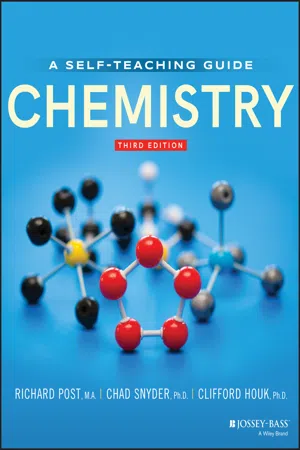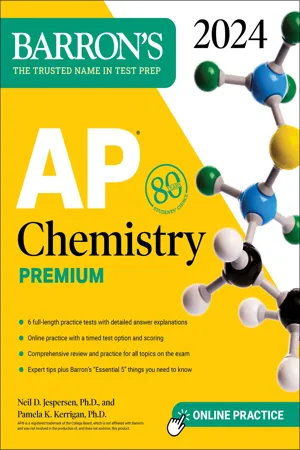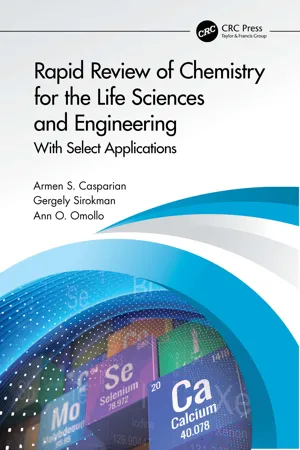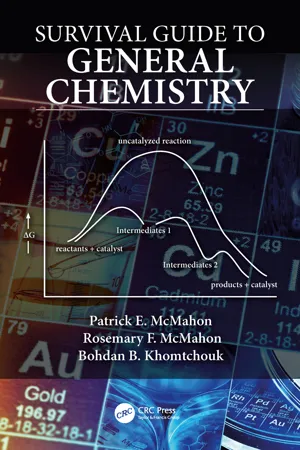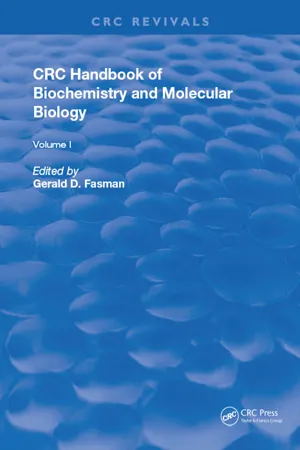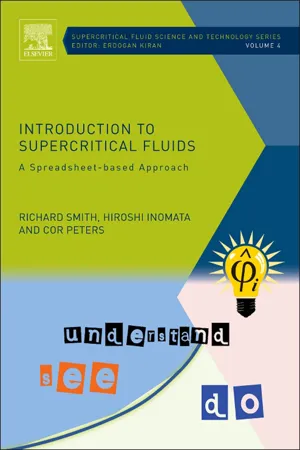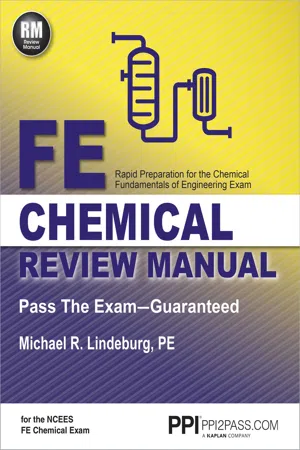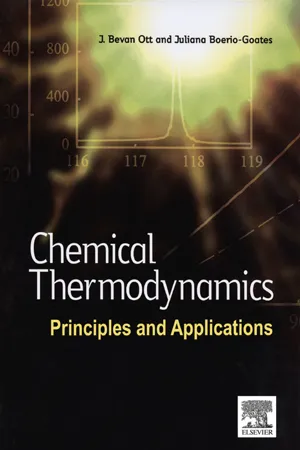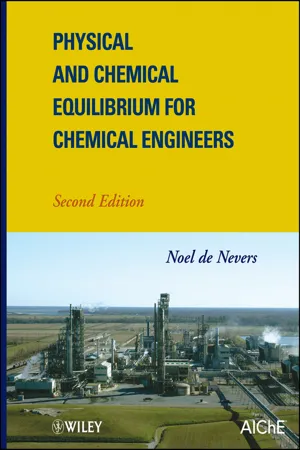Chemistry
Calculating Equilibrium Constant
The equilibrium constant is a measure of the extent to which a chemical reaction reaches equilibrium. It is calculated by taking the concentration of the products raised to their coefficients in the balanced chemical equation and dividing by the concentration of the reactants raised to their coefficients. The equilibrium constant provides insight into the position of the equilibrium and the relative concentrations of reactants and products.
Written by Perlego with AI-assistance
Related key terms
Related key terms
1 of 4
Related key terms
1 of 3
11 Key excerpts on "Calculating Equilibrium Constant"
- No longer available |Learn more
- Steven Boone, Drew H. Wolfe(Authors)
- 2011(Publication Date)
- Collins Reference(Publisher)
c . The equilibrium constant equals the product of the molar concentrations of the products, each raised to the power that corresponds to their coefficients in the balanced equation, divided by the product of the molar concentrations of the reactants, each raised to the power corresponding to their coefficients. Equilibria that have reactants and products in more than one phase are heterogeneous equilibria, and those in which all substances in one phase are homogeneous equilibria.If the value of the equilibrium constant is greater than one (K c > 1), the magnitude of the numerator (products) of the equilibrium expression is larger than that of those of the reactants. If the value of K c is less than one (K < 1), the equilibrium concentrations of the reactants are usually greater than those of the products.Equilibrium constants for gas-phase equilibria are often expressed in terms of their partial pressures. This is known as the K p equilibrium constant. The following equation shows the relationship of K p to K c .K p = K c (RT) ΔnEquilibrium constants are obtained by measuring the equilibrium concentrations or partial pressures of each component of an equilibrium mixture and substituting these values into the equilibrium expression.Before a system reaches equilibrium, the concentrations or partial pressures are expressed in terms of the reaction quotient, Q . The expression for Q is in the same form as that of K . The value of Q is used to determine the direction from which an equilibrium develops. Concentration, pressure, volume, and temperature changes affect the concentrations of the components of a chemical equilibrium. Their effects may be predicted by the application of Le Chatelier’s Principle, which states that equilibrium systems tend to absorb any changes that may occur in such a way to reduce the change and return to a state of equilibrium.Test Yourself1. Write the equilibrium expression for the following. - eBook - ePub
Chemistry
Concepts and Problems, A Self-Teaching Guide
- Richard Post, Chad Snyder, Clifford C. Houk(Authors)
- 2020(Publication Date)
- Jossey-Bass(Publisher)
equilibrium constant is the ratio of the concentration of the products divided by the concentration of the reactants at equilibrium and at a specified temperature. The equilibrium constant (product concentrations divided by reactant concentrations) is valid only at a specified temperature after the reaction has gone to (completion, equilibrium) __________Answer: equilibriumBelow is a reversible reaction and the expression for the equilibrium constant for this reversible reaction.The symbol Keqrepresents the equilibrium constant and the brackets [] represent the concentration (usually in moles per liter) of each product and reactant. Look at the placement of each reactant and product in the equilibrium constant expression. In the equilibrium constant expression for a reversible reaction, the (products, reactants) ____________ are located in the numerator or upper part of the fraction and the (products, reactants) ________________ are located in the denominator or lower part of the fraction.Answer: products; reactantsThe standard equation, then, for Keqis as follows.Write the equilibrium constant expression for the following reversible reaction.Keq= ___________________Answer:(Since there are two products, they should be placed in the upper part of the fraction. The one reactant belongs in the lower part of the fraction.) - No longer available |Learn more
- Neil D. Jespersen, Pamela Kerrigan(Authors)
- 2023(Publication Date)
- Barrons Educational Services(Publisher)
aq) ions cancel. When reactions are added, the equilibrium constants are multiplied:Determining the Value of the Equilibrium ConstantThe equilibrium constant, K, has a numerical value that may be determined by a variety of methods. The most direct method is to measure the concentration of each reactant and product in the mixture. For example, when sulfur dioxide reacts with oxygen to produce sulfur trioxide, the reaction and equilibrium law may be written as in Equation 9.3 :If the concentrations at equilibrium are determined as [O2 ] = 2.0 × 10− 8 M, [SO2 ] = 3.4 × 10− 9 M, and [SO3 ] = 0.971 M, they can be substituted into the equilibrium law to calculate the value of the equilibrium constant:This method of determining the value of an equilibrium constant requires three measurements, and if Kc is very large or very small, it can lead to considerable experimental error. In addition, it may be impossible to analyze the mixture for all possible components. Other ways to determine the equilibrium constant, based on chemical stoichiometry, are described later in this chapter.Using the Equilibrium ExpressionExtent of Reaction and Thermodynamically Favorable Reactions
The value of the equilibrium constant indicates the extent to which reactants are converted into products in a chemical reaction. If the equilibrium constant is large, it indicates that the amount of products present at equilibrium is much greater than the amount of reactants. A very large equilibrium constant, greater than 1010 , for example, means that for all intents and purposes the reaction goes to completion. Conversely, when K is very small, less than 10− 10 , very little product is formed and virtually no visible reaction occurs. If K - eBook - ePub
Rapid Review of Chemistry for the Life Sciences and Engineering
With Select Applications
- Armen S. Casparian, Gergely Sirokman, Ann Omollo(Authors)
- 2021(Publication Date)
- CRC Press(Publisher)
4 Chemical EquilibriumDOI: 10.1201/9781003092759-44.1 Basic Concept
Reaction equations describe substances, called reactants, which when put together react and produce other different substances, called products. It may appear as if only products remain after the reaction is finished. In reality, many reactions do not go to completion, even if the reactants are present in stoichiometric ratios or amounts. Rather, they reach a condition known as equilibrium, denoted by double, reversible arrows in the reaction equation. Equilibrium means that there is a balance between the reactant side and the product side, or simply between the reactants and the products, and that the reaction is reversible. The chemistry of many air pollutants falls and many bodily functions under the heading of equilibrium reactions. The equilibrium condition is dynamic, not static, allowing microscopic changes in reactant and product concentrations to take place, such that no net change in reactant or product concentrations occurs, provided that no external stresses are applied. At any given time, all species in the reaction equation—reactants and products—are present at equilibrium in varying amounts. The relationship among these varying amounts can be described by a mathematical formula known as the equilibrium constant expression or simply the equilibrium expression. The equilibrium expression is set equal to an equilibrium constant symbolized by Kc .An equilibrium reaction can be generally represented as follows:a A + b B ⇋ g G + h H(4.1)The Kc expression can then be expressed as follows:(4.2)K c=[ G ]g[ H ]h[ A ]a[ B ]bwhere a, b, g, and h represent the stoichiometric coefficients in the balanced reaction, and the brackets [ ] indicate molar concentrations. The simplest interpretation of Kc is that it is a measure of the extent to which a reaction goes toward completion, i.e., a reaction where the product side is favored. The meaning of Kc - eBook - ePub
- Patrick E. McMahon, Rosemary McMahon, Bohdan Khomtchouk(Authors)
- 2019(Publication Date)
- CRC Press(Publisher)
constant, K (or K (subscript) to indicate a specific type of reaction). One conceptual view of equilibrium is described through the general rate expressions for the forward and reverse reactions (a more exact derivation can be developed using the techniques described in Chapter 24): k (forward) [A] x [B] y = k (reverse) [C] x [D] y ; this equation can be rewritten as: k (forward) k (reverse) = [C] x [D] y [A] x [B] y where k (forward) k (reverse) is related to the equilibrium constant K. An equation that expresses the correct equilibrium concentration ratio equal to the equilibrium constant (either the symbol or its actual numerical value) is termed the equilibrium expression: K (forward reaction) = [C] c [D ] d / [A] a [B] b The equilibrium constant, K, has a specific numerical value determined by the concentrations of each molecule in the balanced equation under specific. conditions. Example: Use the general definitions to write the complete equilibrium expression for the following reversible reaction; the symbol, K, is used since no numerical value is given. CH 4 + 2 Cl 2 → CH 2 Cl 2 + 2 HCl ← K = [C H 2 C l 2 ] [HCl ] 2 [C H 4 ] [C l 2 ] 2 Example: Assume that under certain conditions, the concentrations at equilibrium of each species in the previous equation are: [CH 2 Cl 2 ] = 0.850 M; [HCl] = 0.145 M [CH 4 ] = 0.0522 M; [Cl 2 ] = 0.166 M. Calculate the numerical value of K. K= [CH 2 Cl 2 ] [HCl] 2 [CH 4 ] [Cl 2 ] 2 = (0.850 M) (0.145 M) 2 (0.0522 M) (0.166 M) 2 K = 1 2. 4 The expression for the reverse reaction could be stated as: K (r e v e r s e r e a c t i o n) = [A] a [B ] b [C] c [D ] d The symmetry of the expressions for the forward and reverse reactions shows - eBook - ePub
- Jeffrey Gaffney, Nancy Marley(Authors)
- 2017(Publication Date)
- Elsevier(Publisher)
7.2, when the reactants of a reversible reaction are first combined, the forward reaction occurs rapidly increasing the concentrations of the products and decreasing the concentrations of the reactants. As the reaction proceeds and the concentration of products increases, the forward reaction slows and the reverse reaction begins to occur. After some time, an equilibrium is reached where the concentrations of reactants and products do not change with time and the forward and reverse reaction rates are equal. This is known as a dynamic equilibrium because, although forward and reverse reactions still occur, the rate of the forward reaction equals the rate of the reverse reaction. So, the ratio of concentrations of the products to the concentrations of the reactants remains constant, although the reaction is constantly proceeding in both directions. Fig. 7.2 A reversible chemical reaction reaches dynamic equilibrium when the rate of the forward and reverse reactions are equal (left) and the concentrations of reactants and products do not change with time (right). 7.2 The Equilibrium Constant Since the concentrations of reactants and products of a reversible reaction at equilibrium are constant, an expression can be written for an equilibrium constant (K eq) that describes the concentrations of the products and reactants at equilibrium. For the generic reversible reaction (3) at equilibrium, the equilibrium constant expression is; K eq = C c D d A a B b (4) As with the acid ionization constants described in Section 5.2, the equilibrium constant for a reversible reaction is expressed as the ratio of the equilibrium concentrations of the products in the numerator to the equilibrium concentrations of the reactants in the denominator. The superscript letters are the stoichiometric coefficients of the reactants and products in the balanced chemical equation - eBook - ePub
Handbook of Biochemistry
Section D Physical Chemical Data, Volume I
- Gerald D Fasman(Author)
- 2018(Publication Date)
- CRC Press(Publisher)
We offer in this report several recommendations with the aim of increasing the usefulness of biochemical equilibrium data and coordinating the results of different investigators. These recommendations include a set of standard conditions which would facilitate the attainment of a common body of knowledge of a wide range of biochemical equilibria. This does not preclude the choice of special experimental conditions that may be appropriate for certain reactions; but whenever possible these reactions should also be studied under the recommended standard conditions. To avoid confusion in interpretation we also recommend standardization of terminology, symbols, and units in the presentation of such data.For other discussions of the presentation of numerical data and of thermodynamic data derived from experiments, we call the attention of the reader to guides prepared by CODATA1 and IUPAC.2PART I. STANDARD CONDITIONS FOR EQUILIBRIUM MEASUREMENTSTrue thermodynamic equilibrium constants are defined in terms of activities of the reactants and products. In many systems of biochemical interest it is not possible to evaluate the activities of all components. It is, therefore, frequently necessary to calculate equilibrium constants in terms of concentrations. The proper quotient of equilibrium concentrations is acceptably constant for many purposes, and will be referred to in this document as the concentration equilibrium constant, with the symbol Kc . However, it should be recognized that values for such equilibrium constants, Kc , and corresponding Gibbs energy changes,Δ, may not be truly constant as the composition of the system is changed.*G c o - eBook - ePub
Introduction to Supercritical Fluids
A Spreadsheet-based Approach
- Richard Smith, Hiroshi Inomata, Cor Peters(Authors)
- 2013(Publication Date)
- Elsevier Science(Publisher)
Chapter 9Chemical Equilibria and Reaction Kinetics
Richard Smith, Cor Peters and Hiroshi Inomata Logic will get you from A to B. Imagination will take you everywhere. Albert Einstein (1879–1955)Tip Box#1 Chapter objectives(1) to review key concepts in thermochemistry (2) to introduce methods for analyzing chemical equilibria (3) to show the effect of nonidealities on “real world” chemical equilibria (4) to introduce thermodynamic analysis of chemical reactors (5) to show how reaction kinetics are used to model reaction pathways9.1 Overview
Chemical equilibria gives one the composition of a reaction system in its most stable state, whereas reaction kinetics gives one the rate at which the chemical species are transformed from their initial state to a final state. Analysis of chemical equilibria helps one to understand the limits of a reaction according to its thermodynamics and the given reaction conditions. Analysis of reaction kinetics helps one to understand how long it will take to make the transformation in reality. Detailed development of chemical equilibria theory is given in many excellent undergraduate textbooks in chemical thermodynamics [CT1 –CT3] and chemical reactions [CT4] .With any type of chemical reaction or process, energy transfer occurs and this is the basis of thermochemistry. The energy transfer of a reaction is described by thermochemical equations, which are balanced stoichiometric equations for the reactant and product chemical compounds. Thermochemical equations are written in terms of the moles of each chemical compound, for example:(9.1)The a and b are stoichiometric coefficients that represent the moles of reactant chemical compounds A and B , respectively, required to form c moles of product chemical compound C . When changes in properties are calculated by treating Eq. (9.1) as a mathematical equation, by convention, the stoichiometric coefficients are positive (+) for products and negative (−) for reactants . Thus, the change in enthalpy of Eq. (9.1) - eBook - ePub
- Michael R. Lindeburg(Author)
- 2016(Publication Date)
- PPI, a Kaplan Company(Publisher)
11The second form ofEq. 52.8relates the equilibrium constant to the total pressure, .Equation 52.9relates the partial pressure to the actual fugacity.12Equation 52.10: Variation of Equilibrium Constant with Temperature52.10AsEq. 52.3shows, the equilibrium constant is related to the equation of state. Since the equation of state contains a temperature term, anything derived from the equation of state depends on temperature. The equilibrium constant’s dependency on temperature is given byEq. 52.10, where ΔH 0 is the standard molar enthalpy of reaction.13 Although the equilibrium constant varies considerably with temperature, ΔH 0 is reasonably insensitive to the temperature. When integrated,Eq. 52.10is essentially the same as the Clausius-Clapeyron equation (and the Arrhenius equation for the temperature dependence of reaction rate constants), and is known as the van’t Hoff equation .4. Reaction RateThe rate of reaction (also known as the reaction velocity ), r A , of component A in a chemical reaction is the rate at which the concentration of component A changes. A reactant that decreases in concentration with time has a negative reaction rate (i.e., r A - eBook - ePub
Chemical Thermodynamics: Principles and Applications
Principles and Applications
- J. Bevan Ott, Juliana Boerio-Goates(Authors)
- 2000(Publication Date)
- Academic Press(Publisher)
is constant and we can write(9.7)and(9.8)Equations (9.7) and (9.8) define K , the equilibrium constant for the reaction.b It is sometimes referred to as the thermodynamic equilibrium constant . As we shall see, this ratio of activities can be related to ratios of pressure or concentration which, themselves, are sometimes called equilibrium constants. But K , as defined in equations (9.7) and (9.8) , is the fundamental form that is directly related to the free energy change of the reaction.9.1a Alternate Forms of the Equilibrium Constant
Alternative forms of the equilibrium constant can be obtained as we express the relationship between activities, and pressures or concentrations. For example, for a gas phase reaction, the standard state we almost always choose is the ideal gas at a pressure of 1 bar (or 105 Pa). Thusand(9.9)where the fugacity must be expressed in bars.c Substitutingfi= φi piinto equation (9.9) , where φi is the fugacity coefficient, gives(9.10)The ratio of pressures in equation (9.10) is known asKpand the ratio of fugacity coefficients is written asJφ. Hence,(9.11)At low pressures , and(9.12)for ideal gases, or gases at low pressure,piis related tocithe molar concentration in the gas phase bySubstitution into equation (9.11) gives(9.13)The expression is the concentration equilibrium constant K c , and equation (9.13) becomes(9.14)Finally,piis related toxi, the mole fraction in the gas phased by Dalton’s lawwhere p is the total pressure. Substitution into equation (9.11) gives(9.15)where(9.16)is the mole fraction equilibrium constant. In summary(9.17)and at low pressures when J φ = 1,(9.18)Alternate expressions can also be written for equilibrium constants in condensed phase reactions. For example, for the reaction - Noel de Nevers(Author)
- 2012(Publication Date)
- Wiley(Publisher)
Eq. 12.36 shows how that would be accounted for (see Problems 12.30 and 12.31).12.11 Other Forms of KThe K shown so far is the basic dimensionless K , formulated in terms of the activities and calculated by Eq. 12.14 . We very often see in its place K p , defined by Eq. 12.32 .Example 12.13 Estimate the value of K p for the formation of ammonia at 150 atm and 400°C.Using the values from Example 12.11, we know that K = 0.013, so that(12.BX)The basic K is dimensionless, but K p has dimensions of pressure to the power.In Chapter 16 we will see that the biochemical engineers and biologists use several other definitions of K that seem useful in their work.12.12 Summary1. Chemical reactions are of paramount importance in chemical and in environmental engineering, and in every aspect of our daily life.2. This chapter and this book deal only with equilibrium, not with the rate of chemical reactions. By using selective catalysts we can influence the rate of reactions so that we produce mixtures that are at or near equilibrium for one reaction, but not for others. Thermodynamics tells us little about that.3. At true thermodynamic equilibrium, any chemically reacting mass of matter has taken up the chemical composition that has the minimum possible Gibbs energy for that T , P , and starting composition. All that we do in this chapter is work out the consequences of this statement.4. The most common formulation is in terms of the law of mass action, which leads to the equilibrium constant K , stated in terms of the activities and stoichiometric coefficients of the reactants and products.5. K is dimensionless, and can be calculated from and T . Other forms of K , such as K p , are widely used; they are often not dimensionless.6. For almost all reactions, changing T changes K and thus changes the equilibrium concentrations.7. Changing P does not change the value of K . It does change the values of K p and
Index pages curate the most relevant extracts from our library of academic textbooks. They’ve been created using an in-house natural language model (NLM), each adding context and meaning to key research topics.
Explore more topic indexes
Explore more topic indexes
1 of 6
Explore more topic indexes
1 of 4

